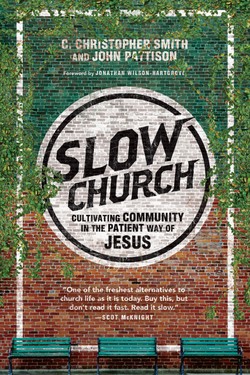Stop what you are doing right now. Well, you don’t have to stop everything, but at least slow down. Maybe you need to stop some things and start others—but whatever you do, it should involve connections. Connections with real humans where you live and not video feeds, mass marketing, programs, automation or social media. Oh yeah, these real humans have stories and needs, so listen and respond.
Although this isn’t exactly a summary of “Slow Church: Cultivating Community in the Patient Way of Jesus” (C. Christopher Smith and John Pattison, InterVarsity Press, 2014), it does begin to get at the authors’ argument and encouragement.
Calling on principles from movements like Slow Food, where local and organic consumption is promoted, Smith and Pattison want Christians to think of their faith communities in similar fashion.
Starting from a belief that the North American church has given itself over to the allure of consumerism and “fast life,” their book attempts to counter what sociologist George Ritzer calls “McDonaldization—the process by which the principles of fast-food restaurants are coming to dominate more and more sectors of American society as well as the rest of the world.”
The four dimensions of McDonaldization outlined by Ritzer are efficiency, predictability, calculability (quantifiable results) and control, principles the authors say are hurting the viability and effectiveness of North American Christianity.
The authors write in the introduction: “Many churches, particularly those driven by church growth models, come dangerously close to reducing Christianity to a commodity that can be packaged, marketed and sold. Instead of cultivating a deep, holistic discipleship that touches every aspect of our lives, we’ve confined the life of faith to Sunday mornings, where it can be kept safe and predictable, or to a ‘personal relationship with Jesus Christ,’ which can be managed from the privacy of our own home. Following Jesus has been diminished to a privatized faith rather than a lifelong apprenticeship undertaken in the context of Christian community.”
The “industrialization” of the church, the authors claim, closely parallels the industrialization of agriculture, where soil has become merely a convenient means of holding up a plant while it’s fed top down by chemical fertilizers. Comparing this to natural growth, where a plant is fed from the ground up and healthy soil is the top priority, the authors turn their sights on the church’s use of “industrial” methods.
“Western Christianity has similarly adopted shortcuts that are the church equivalent of imposing a mechanistic mindset onto a biological world. When evaluated in terms of efficiency—defined as the easiest way to get someone from here to there, from unsaved to saved, from unchurched to churched—these top-down inputs seem to yield impressive short-term results: they can sometimes pack the pews. So on the upside, the church has been busy.”
On the downside, recent evidence suggests that these methods don’t create long-term church growth, attendance or adherence to Christian principles. They may even hurt the expansion of Christianity. Much of the growth attributed to the mega-church movement, for instance, is merely a reshuffling of the deck as people migrate in, and ultimately out, of large churches disconnected from a local context.
And this is where Slow Church finds its heart—the importance of Christians making connections and ministering in their local contexts. The authors argue that a church’s structure, denominational affiliation, size and demographics influence its effectiveness far less than does its ability to engage with the needs of its community and the people who live there.
Historic models, such as the house church and the parish, are used to illustrate local engagement, as is the pattern found in Acts, where the church united to provide resources out of its abundance to those in need.
“Slow Church” is also countercultural, encouraging social values foreign to many North American Christians in chapters on stability, patience, Sabbath, gratitude and hospitality, among others. In doing so, the book is a challenge and an invitation for the church to consider how and where it finds its mission field and how it can be “good news” for communities.
When asked if he thinks the book will foster a movement, co-author Pattison said: “Neither Chris nor I have ever referred to ‘Slow Church’ as a movement. Actually, we do think there is a movement. It's called 'Church.' It's been around for 2,000 years, and it will be around long after everyone has forgotten about ‘Slow Church.’ Our goal hasn't been to inaugurate a movement; it's been to foster a conversation.”
-----
The Presbyterian Outlook will host a 90-minute webinar “Slow Church: Toward a Deeper Life Together” with C. Christopher Smith, co-author of “Slow Church” on Tuesday, June 9, at 2:00 p.m. EST. The cost of the webinar for up to six participants is $29.95. A DVD of the event can be pre-ordered for $43.95.

